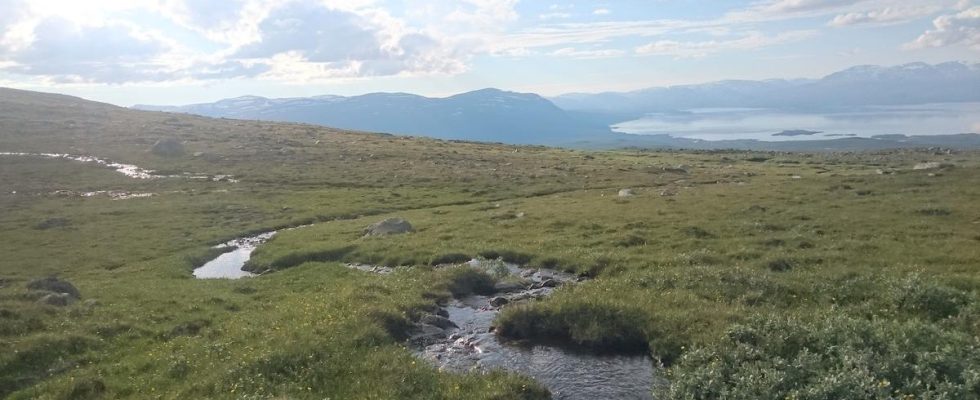Watercourses in northern regions release high levels of methane gas into the atmosphere. Photo: Gerard Rocher Rose
Studies show that the Earth’s freshwater system accounts for half of the global emissions of methane, a powerful greenhouse gas that contributes to global warming. Now researchers at SLU and Umeå University, in collaboration with researchers in the USA, have published a study in Nature which provides new insights into global levels, patterns and drivers of methane emissions from watercourses. Somewhat unexpectedly, the researchers found that metaShow more
Latest news
Agneta Elmegård
yesterday10.08
A new study conducted on people living in the inner city of Stockholm shows that residents run a greater risk of developing dementia even with a minimal increase in airborne particles. Photo: RASMUS WALLDÉN
Small increases in airborne particles raise the risk of dementia significantly. This is shown by a study that examined the health of people living in central Stockholm.
Even low concentrations of air pollution are associated with poorer health, and previous research has found a link between air pollution and dementia risk. Now researchers have investigated this connection.
– There is a significant indirect effect aSee more
Agneta Elmegård
Tuesday 10.41
The moss Takakia lepidozioides in fossil form from the Jurassic period (left) and modern specimens. The species may soon be extinct, scientists warn in a new study published in Cell. Photo: Cell/Study
The world’s oldest moss, Takakia lepidozioides, is about to disappear from the flora. It is thought to have existed for 400 million years and survived both dinosaurs and environmental disasters, but due to climate change and global warming, it does not have time to adapt and is fading away. Researchers of a new study, published in the journal Cell, warns that it could be completely gone within 100 years. Mossan finnShow more
Christina Nordh
11 August 08.16
Too few green areas mean that you cannot handle the downpours. Here a flood in Gävle. Photo: LOTTE FERNVALL
After heavy downpours and persistent rain, Sweden’s major cities are now planning to divert large amounts of water.
In July 2013, the floors of the operating rooms at Ryhov in Jönköping were filled with water, sewage in Östersund is suspected to be behind the fact that 20,000 people fell ill after floods, writes TT.
Stockholm, Gothenburg and Malmö, among others, are now planning to divert the torrential water masses to places Show more
Christina Nordh
9 August10.22
The annual rings of the pine trees have been measured using a new method. Photo: AFTONBLADET
In recent decades, temperatures have been significantly warmer than any other period in the last 1,200 years.
This is reported by researchers from the University of Gothenburg in the scientific journal Nature after a new time series based on the trees’ annual rings.
Researchers from the University of Gothenburg together with an international team have used a new method to measure the cell wall thickness of the cells in the annual ringSee more
Show more posts
Ask us
check Ask your questions to the editors here!
Have looked everywhere about the forest fire around Norberg. Assume it is under control as there is no news.
Hugo
Hello! News about the forest fire in Norberg can be found here. And here.
When will politicians learn the difference between environment and climate?
The climate is the relationship with the sun, the movements of the earth which are the major factors. Sweden’s role in this does not exist at all, in contrast to China, which emits enormous amounts of carbon dioxide and increases the burning of fossil substances every year by 33 times Sweden’s total emissions. Our politicians strain mosquitoes and swallow elephants. The attack to save the environment & climate is not about Sweden at all, but rather countries like China.
Lena Karlsson
Haven’t read in the online newspaper about the new findings from SLU about bald cutting, why?
Anders Eriksson
What responsibility do municipalities have for the climate? In my vicinity, I see a municipality in an expansive phase where they don’t even seem to have thought about e.g. emissions from traffic, noise, access to groundwater, the impact on nearby watercourses.
Annie
The truth is that many municipalities are lagging behind in this work and there is no regulated “agreement” between the state and municipalities to act against Agenda 2030 or the national climate goals in 2045.
I’m a little tired of trudging around among washed-up plastic and other trash here on the west coast. There is a beach cleaner map and many cleaners but it must be stopped at the source. What is being done on that front?
Pray
Show more posts
The Skåne coast is identified as a national risk area for flooding and erosion – Löderup’s beach is particularly vulnerable.
– Climate change means that we have to abandon the view of what the coasts look like today, says Per Danielsson at the Norwegian Geotechnical Institute.
Kristianstad is Sweden’s lowest situated city.
New and higher dikes are now being built.
– We are doing this to protect the city against high tides and future sea level rises, says Karl Erik Svensson, project manager for the dike construction.
